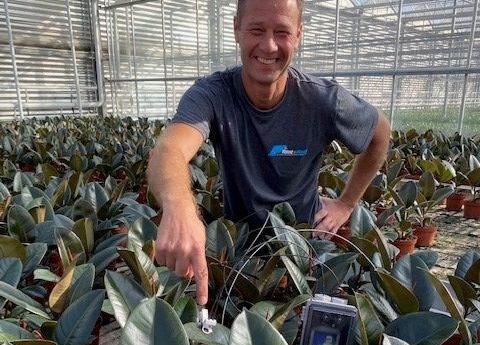Pantar in Amsterdam / Amstelveen offers people with a social disability more than only a pleasant working environment. For many people this is the first step to suitable and paid work. With a team of 250 employees the aim of Jaco Vreugdenhil, cultivation manager at Pantar, is to strengthen the plant processes to create high plant quality. Thanks to Sendot's photosynthesis and oxygen sensors, Jaco has been able to improve their cultivation process.
As a Westlander and experienced and professional cultivation manager, Jaco Vreugdenhil has a passion for plants and people. He enjoys driving daily from the “Glass City” to Amsterdam, where the 1.5 ha horticultural business is located. On the edge of the Westpoort area, he teaches his people the basic knowledge and skills they need for good pot plant nursery. “Training people and replacing them to a commercial organisation is our main goal ”, he says with conviction. "We think in terms of possibilities, not limitations."
Digitization
Vreugdenhil also applies this way of thinking to cultivation, which mainly consists of ficuses. “We have a 1 ha greenhouse, divided into four sections with different climates,” he explains. “Three are intended for the Ficus in 12 cm pots and in one section we grow Sundaville tub plants.
The cultivation manager always strives for top quality and efficiency in the process. Careful cultivation and digitization are therefore of paramount importance. It also explains why he uses the wireless 30MHz data platform, which is geared towards professional horticulture. This platform can be used to collect, visualize and share data from different sources, like the Sendot sensors. This can help growers digitise and make their production processes more efficient.
“Via 30MHz I was introduced to Sendot Research, which develops plant sensors,” says the Westlander. “I closely follow the digital developments in greenhouse horticulture, so you understand my interest. Sendot has supplied plant sensors for a joint initiative. These sensors have been part of our process for months now. ”
New insights
In the spring of 2020, Vreugdenhil received a photosynthesis sensor and an oxygen meter. He has used both since then and realized already within two weeks that the cultivation process had to change on some fundamental points.
“We were used to watering during the day, which is also common for commercial companies,” explains the manager. "The oxygen and photosynthesis measurements showed that the water content in the pot remained high for too long, causing the plants to experience oxygen stress in the root zone and not being able to grow optimally."
As a trial, Vreugdenhil started watering in the evening, so that the pots could drain during the non-active night period and the roots had sufficient oxygen again when the light came. “According to the photosynthesis measurements, it was a golden move,” says the plant grower enthusiastically. “After a few weeks I could also see it clearly from the roots in the root zone, which were finer and more firmly rooted. The plants themselves, which were compact as always, were also fuller. It may sound simple, but without sensors I would still continue working as it was. ”
Quality assurance
“An advantage of applying the Sendot sensors is simply that we have a higher degree of quality assurance of our plants and much more control over our process. Naturally, our customer benefits from this, says Vreugdenhil. ”
“I also think it is important that we can continue to teach people with skills for a suitable job in greenhouse horticulture. And knowledge about digitization and working with sensors is an important part of this.
